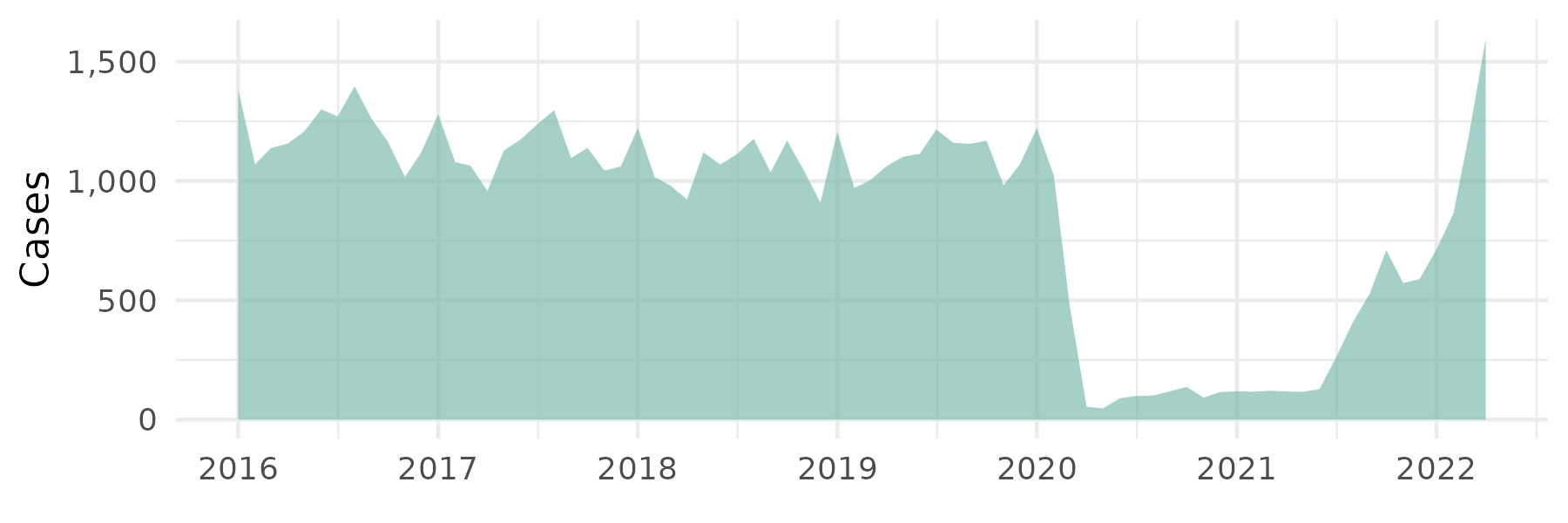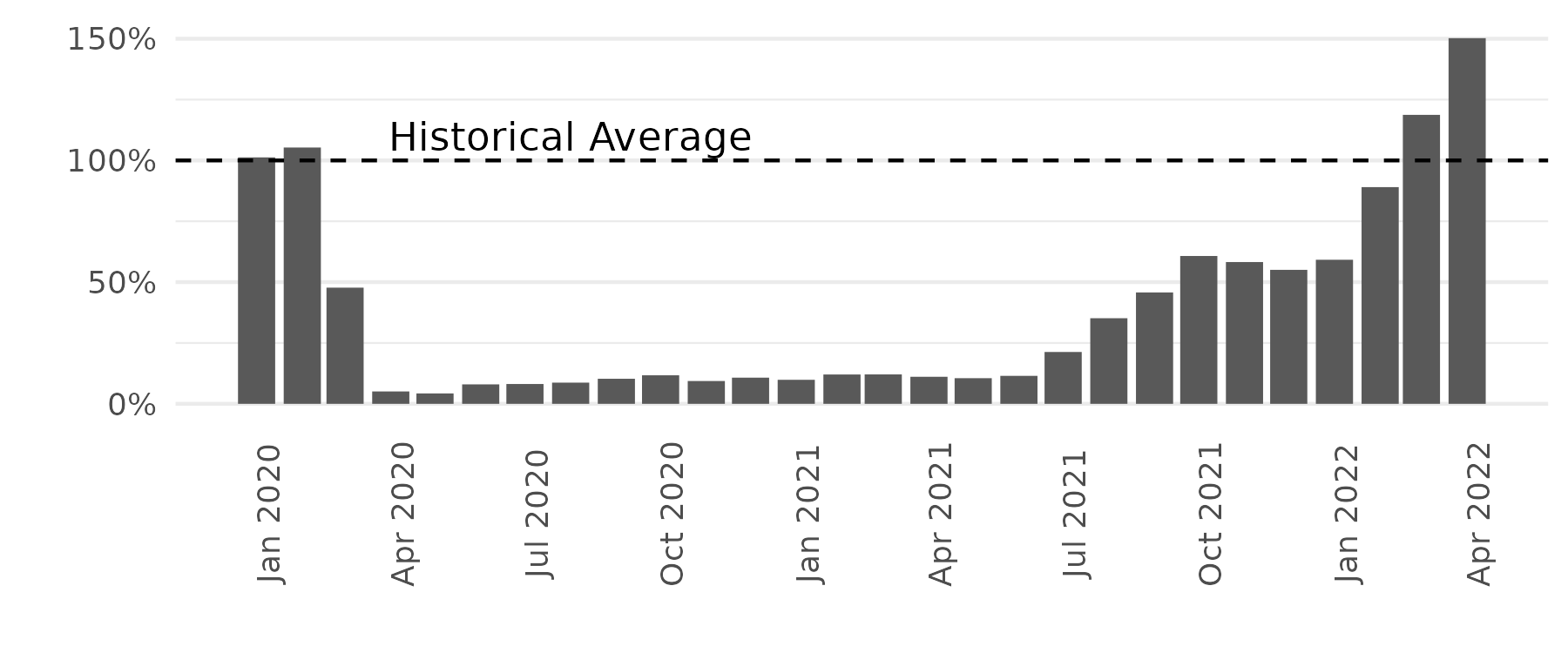Minnesota Eviction Filings
Note: View different map layers by selecting the buttons at the top right of the map. Click on tracts and counties to see pop-ups with more information.
 Data collected by: Dan Bernstein @Legal Services Corporation - Civil Court Data Initiative
Data collected by: Dan Bernstein @Legal Services Corporation - Civil Court Data Initiative
Analysis by: Julia Greenberg, Ashley Santos, Hannah Moore, Amit Cohen, Tim Thomas @U.C. Berkeley’s Urban Displacement Project
Updated: December 7, 2022
Summary
- Despite local, state, and federal moratoria, over 9,500 renters had evictions on file in Minnesota during the pandemic.
- The bulk of the state’s evictions occurred in Saint Paul and north of Minneapolis as well as in the rural counties surrounding Duluth.
- State moratoria helped decrease evictions during the pandemic until July 2021, when cases started to increase to 50% of historical average levels between October 2021 and January 2022. (We will expand on the effects of local moratoria in the coming month.)
- By March 2022, eviction filings surpassed historical averages, and reached 150% of historical average levels in April.
- Before the pandemic, roughly 1 in 33 Black and "Other Racial Group"1 renters had an eviction filing. Local moratoria greatly reduced these rates to about 1 in 150 renters. Still, these two groups consistently experienced higher eviction rates than Latine, White, and Asian renters.
This state profile analysis is a collaboration with the Legal Services Corporation. To learn more about the data we used and how we created these maps and plots, see our methodology page.
Moratoria greatly reduced evictions
Cases over time

Desktop users: To filter by county, click on its name once. To zoom in on the plot, click and drag to select the area you wish to zoom in on. To reset the plot, double click anywhere inside of it.
The graph above shows evictions by county in Minnesota from 2016 to 2022,2 with counties experiencing the most evictions at the top and the counties experiencing the fewest evictions at the bottom.3 Hennepin County, where Minneapolis is located, had the most evictions of any county in the state throughout the entire time period followed by Ramsey and Dakota Counties. The graph shows that in all counties, evictions dropped sharply after the first eviction moratorium in March 2020, and remained low until they started to sharply increase in the latter half of 2021.
Note that data is updated as recent case information becomes available.
Eviction counts have surpassed historical average
PANDEMIC EVICTION CASES VS. HISTORICAL AVERAGE

Minnesota evictions dropped to 95% below historical average in April 2020 after the pandemic began and stayed relatively low (no higher than 11% of the historical average) until July 2021, when they began to climb towards pre-pandemic levels. By March 2022, evictions were 19% above the historical average, and in April 2022 they were 50% above average.
Black and "Other Groups" disproportionately evicted
Eviction case rate by race
Eviction filing rates between 2016 and 2021 were consistently highest among Black renters and renters in "Other Groups".4 Eviction rates among all racial/ethnic groups dropped sharply during the pandemic.
Asian, Black, Latine, and Other Groups eviction rates compared to White eviction rates
This graph demonstrates the amount by which the estimated eviction rates of Asian, Black, Latine, and "Other group" renters compare to the estimated eviction rate for White renters. A ratio greater than 1 means that there is a greater eviction filing rate for non-White renters than White renters. A ratio less than 1 means the opposite - there is a lower eviction filing rate for non-White renters than White renters.
Black, Latine, and "Other group" renters have ratios greater than 1 throughout the entire time period (except for Latine renters in 2021, when the ratio dips below 1) while Asian renters have ratios less than 1. The ratios for Black, Latine and Asian renters for all groups decrease in 2021.
This page will continue to be updated with new data and content. Follow us on twitter @EvictionNet for these updates.
Data table coming soon
1. Individuals considered part of the "Other Racial Group" category in this analysis do not identify as White, Black, Latine or Asian. This category includes, among others, people of mixed race and Indigenous people.↩
2. For the purposes of this report, '2022' ends with April 2022. There is still time left in 2022 for these yearly average rates and ratios to change, and trends that are observed now may be quite different by December.↩
3. Because we analyze eviction filings, we are likely underestimating the number of households that were forced to leave their home. An eviction filing marks the point at which formal eviction proceedings have begun. However, households may leave their home at many different points in the eviction process. For example, some leave after receiving an eviction notice but prior to the eviction filing. Others who are threatened with an eviction leave even earlier, before receiving a notice (these cases are known as "illegal evictions"). Alternatively, not all eviction filings lead to a removal, as some renters work out a deal with their landlord that allows them to stay in their homes. We are not currently able to track this information given the limited nature of our data; however, we are working on potential solutions.↩
4. The race/ethnicity of each individual defendant is estimated using their last name and the racial composition of the census tract where they lived. Because the majority of census tracts in the state are 'mostly White' (see the segregation map layer above), some non-White individuals may have been mis-categorized as White if they lived in tracts with high White populations. Therefore, these plots show a conservative estimate of the racial disparity in eviction cases because we are likely overcounting evictions among White renters and undercounting evictions among non-White renters.↩
